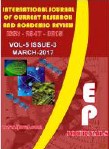Abstract Volume:5 Issue-3 Year-2017 Original Research Articles
 |
Online ISSN : 2347 - 3215 Issues : 12 per year Publisher : Excellent Publishers Email : editorijcret@gmail.com |
2Department of Botany, Faculty of Science, Benghazi University, Benghazi, Libya
The control of indoor air quality plays an important role in the prevention of cross infection in hospitals to protect both hospital staff and patients. This study was carried out to determine the variation in microbiota of medical laboratory at Benghazi center infectious diseases and immunity. Samples were collected by using the settled plate techniques for the enumeration of bacterial and fungal isolates. The air specimens were collected through four seasons in the morning between the hours of 9 am and 11 am from air indoor medical lab and swab samples collected from the filters of the air conditioning units in autumn, spring and summer seasons. Indoor air gram positive bacteria, accounting (99.72%) was significantly higher than that of gram negative bacteria (0.28%). The most common bacteria genus found in all seasons were Staphylococcus (46.62%) Micrococcus (27.31%), followed by Kocuria (13.42%). Micrococcus luteus and Kocuria rosea were found frequently occurring airborne bacterial isolates in the four seasons. Gram negative bacteria were only found in autumn and summer seasons only. Rest room had the highest bacterial count (43.47 CFU/m3) while the microbiology room had the lowest (3.66 CFU/m3). The susceptibility pattern of all isolates revealed sensitivity to all tested antibiotics. Aspergillus spp., Penicillium spp. and Alternaria spp. were frequently dominant air borne fungal isolates. Bacterial concentration (0.26 CFU/m3 air - 38.49 CFU/m3 air) in investigated filters of air conditioning unites while fungal concentration was (0.26 CFU/m3 - 51.59 CFU/m3). The most abundant isolated bacteria in the three seasons was Bacillus circulans while Penicillium sp. was the most abundant fungi in air conditioning isolates. In indoor air samples of medical laboratory rooms showed contamination with bacteria and fungi under the acceptable levels, when compared with cited in this study. Indoor airborne bacteria and fungi concentration were depended on place of isolation and seasons.
How to cite this article:
Muna M. Buzayan and Fauzia R. El-Garbulli. 2017. Microbial Air Quality in Medical Laboratory Rooms at Benghazi Center of Infectious Diseases and Immunity.Int.J.Curr.Res.Aca.Rev. 5(3): 71-79doi: https://doi.org/10.20546/ijcrar.2017.503.011



Quick Navigation
- Print Article
- Full Text PDF
- How to Cite this Article
- on Google
- on Google Scholor
- Citation Alert By Google Scholar
